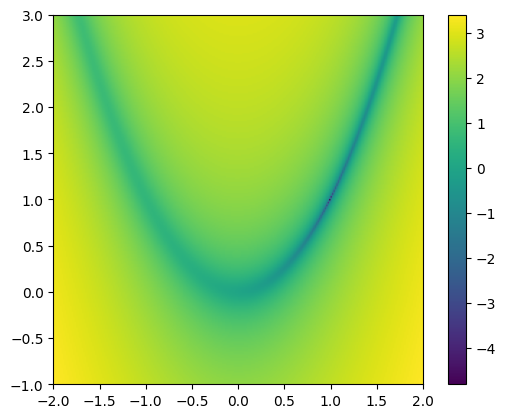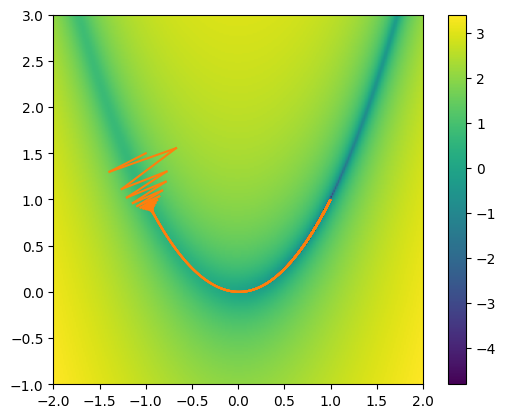Gradient Descent#
Gradient descent is a simple algorithm for finding the minimum of a function of multiple variables. It works on the principle of looking at the local gradient of a function then then moving in the direction where it decreases the fastest.
Warning
There is no guarantee that you arrive at the global minimum instead of a local minimum.
Given a function \(f({\bf x})\), where \({\bf x} = (x_0, x_1, \ldots, x_{N-1})\), the idea is to first compute the derivative:
and then move in the opposite direction by some fraction, \(\eta\):
There are different ways to define what \(\eta\) should be, but we’ll use a fixed value. We’ll call \(\eta\) the learning rate.
Let’s demonstrate this.
import numpy as np
import matplotlib.pyplot as plt
Test function#
The Rosenbrock function or the banana function is a very difficult problem for minimization. It has the form:
and for \(a = 1\) and \(b = 100\), the minimimum is at a point \((a, a^2)\).
def rosenbrock(x0, x1, a, b):
return (a - x0)**2 + b*(x1 - x0**2)**2
def drosdx(x, a, b):
x0 = x[0]
x1 = x[1]
return np.array([-2.0*(a - x0) - 4.0*b*(x1 - x0**2)*x0,
2.0*b*(x1 - x0**2)])
Let’s plot the function
xmin = -2.0
xmax = 2.0
ymin = -1.0
ymax = 3.0
a = 1.0
b = 100.0
N = 256
x = np.linspace(xmin, xmax, N)
y = np.linspace(ymin, ymax, N)
x2d, y2d = np.meshgrid(x, y, indexing="ij")
fig, ax = plt.subplots()
im = ax.imshow(np.log10(np.transpose(rosenbrock(x2d, y2d, a, b))),
origin="lower", extent=[xmin, xmax, ymin, ymax])
fig.colorbar(im, ax=ax)
<matplotlib.colorbar.Colorbar at 0x7f37007eea50>

Implementing gradient descent#
Let’s start with an initial guess. We’ll keep guessing until the change in the solution is small.
Note: our success is very sensitive to our choice of \(\eta\).
x0 = np.array([-1.0, 1.5])
We’ll set a tolerance and keep iterating until the change in the solution, dx is small
def do_descent(dfdx, x0, eps=1.e-5, eta=2.e-3, args=None, ax=None):
# dx will be the change in the solution -- we'll iterate until this
# is small
dx = 1.e30
xp_old = x0.copy()
if args:
grad = dfdx(xp_old, *args)
else:
grad = dfdx(xp_old)
while dx > eps:
xp = xp_old - eta * grad
if ax:
ax.plot([xp_old[0], xp[0]], [xp_old[1], xp[1]], color="C1")
dx = np.linalg.norm(xp - xp_old)
if args:
grad_new = dfdx(xp, *args)
else:
grad_new = dfdx(xp)
#eta_new = np.abs(np.transpose(xp) @ (grad_new - grad)) / np.linalg.norm(grad_new - grad)**2
#eta = min(10*eta, eta_new)
grad = grad_new
xp_old[:] = xp
do_descent(drosdx, x0, args=(a, b), ax=ax)
fig

momentum#
A variation on gradient descent is to add “momentum” to the update. This means that the correct depends on the past gradients as well as the current one, via some combination. This has the effect of reducing the zig-zag effect that we see in our attempt above.


